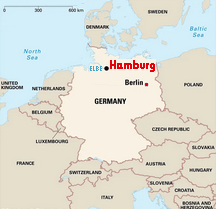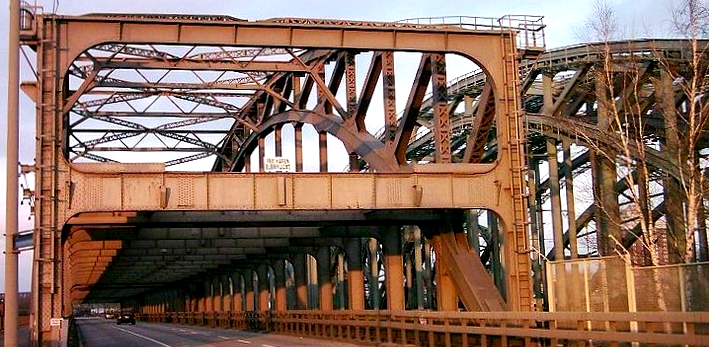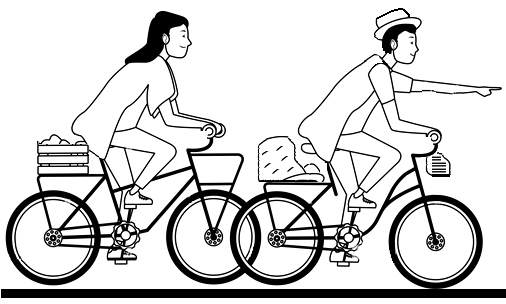

Hamburg is Germany's largest harbor, located at the river Elbe, which goes into the North Sea.



Hamburg is also the capital of the state Hamburg (same name), one of Germany's 16 federal states. The city of Hamburg has 1.9 mio residents, and it is the second-largest city of Germany (after Berlin).
List of main events:
// 808: Foundation - Castle "Hammaburg" erected on order of Charlemagne
// 834: Hamburg became seat of a bishop
// 845: Viking ships sailed to Hamburg and destroyed it
// 1189: Emperor "Barbarossa" made Hamburg a Free Imperial City
// 1201: Denmark king raided and occupied Hamburg
// 1250: Hamburg, now member of Hanseatic League, becomes major port in Northern Europe
// 1350: Black death killed 2/3 of population
// 1529: linked to Lutheranism

// 1630: Fortifications of Hamburg enlarged
// 1806: Becoming sovereign state as "Free and Hanseatic City of Hamburg"
// 1814: For 10 years part of Napoleon's empire
// 1815: In Vienna Congress confirmed as independent
// 1842: The "great fire" destroyed about 25% of the inner city
// 1857: Start of the "P" line of mighty sail ships by Laeisz
// 1860: Modern semi-democratic constitution
// 1900: "Hamburg-America Line" became the world's largest transatlantic shipping company
// 1943: Firebombing by the English and the USA airforces widely destroyed Hamburg
// 1948: The split of Germany had bad impact on Hamburg's harbor
// 1962: Huge North Sea Flood reached Hamburg, covering 20% of the city
// 1990: German reunification - chance to re-establish Hamburg as strong deep-sea por

This cartoon shows the essential features of Hamburg: Townhall, St Michael church, fish market.
The following map presents Hamburg's centre, including the Alster river and lake, the Elbe and the northern part of the harbor.

The main local ship connections and the underground railway lines, [U] and [S], are marked. Hamburg's townhall ("Rathaus") is the red building right in the middle of the map.
Hamburg's townhall is the dominant building of the city. It was erected rather recently, 1886 to 1897. A new townhall was needed after the previous one had been destroyed in Hamburg's cruel city fire in 1842. The very high tower measures 112m.

In the older quarters are still many traditional buildings, including this cute café.

There are several large churches in Hamburg. The most popular one is the St Michaelis church, completed in 1762, which has a tower of 132m.
The highest tower is/was that of the St Nicholai church, completed in 1195, 148m. It was destroyed in WW-2 in 1943, and only the ruin of the tower remains.


Beside all 'classical' architecture, Hamburg has a few modern and highly appreciated buildings. Here are just two:
The "Chilehaus" was built in 1925, almost completely with bricks, and its architecture is stunning. Here are a few bits of it:



Not surprisingly, in 2005 the Chilehaus was declared a UNESCO World Heritage Site.
Very famous, and rightly so, is the truly impressive "Elbe Theatre", located in the harbor. It is far more than a theatre, it's now Hamburg's cultural center.

Hamburg is also the "bridge city" - more than 2000 are there. The by far biggest ones are over the large river Elbe south of the city.



Bridges crossing the Elbe were a very late achievement: 1872 the railway bridge, 1887 the road bridge, both steel constructions..
In Hamburg there has always been a large number of fishing ships. Accordingly, the fishmarket, located at the northern side of the Elbe, is a large venue for hundreds of years. Its central building is crowded every Sunday morning, and any kind of fish is on offer there. One can also step down to the pier for fisher boats and buy freshest fish right there.



Hamburgs harbor is not the largest in Europe anymore, these are now Rotterdam and Antwerpen - but it is still a big one, used by lots of freight ships, and cruise ships as well.
The passenger building for local commuter ships has a large, somehow symbolic, tower.
Several historic ships can be seen in the harbor as well.

This essay will not cover the many facets of this harbor. - - however, a look back in history shall happen, especially the time when Germany had the fastest cargo sail ships, and Hamburg was the essential harbor for this enterprise.
These ships were called the "P ships", because Carl Laeisz, the owner of the famous "Flying P Line" in Hamburg/Germany, named all his ships with a "P" name. The first one, in 1857, was called "Pudel". In 1926 his company installed the last P-ship, the "Padua".

Many of the P ships died or were scrapped. Yet the Padua, a 3-masts bark, stayed vivid. It is not the largest but one of the most powerful P ships.
After WW-2, in 1945. Germany had to hand it over to the Sovjet Union. There it was renamed as Kruzenstern, and is since until today used as a school ship, under Russian flag.

Finally - in 1958 the German Navy installed the sail ship Gorch Fock as training ship. It was built by the Hamburg company Blohn & Voss, as a replica of the original Gorch Fock from 1933, which after WW-2 was taken by the Sovjet Union. This well-known sail ship is still in full use.
Yes, Hamburg owns islands, one of them, Neuwerk, since 1299 - the only one which is populated, 40 people.
The lighthouse there, erected 1310, is actually the oldest still standing building of Hamburg!


Neuwerk can be reached from Cuxhaven with ships, horse-drawn coach ("Wattwagen"), or just walking - which is hard yet fun.
That's easy, by trains, buses, planes and ships - Hamburg has a large railway station, a large bus center, a large airport and of course a large harbor.

Beside all this, very energetic people can even cycle there, and some actually do so!
Yes, there is lots to do in Hamburg - all the buildings, the exciting harbour with big ships, the gorgeous fish market, theater & opera & jazz - too much?
Well, in the middle of the city is the peaceful Alster river and lake - - a pleasant place to walk or cycle or camp or just sit there and do nothing, yet nevertheless see the towers of some churches and especially of the townhall ... Hopefully even the sun will shine!

At the end of this essay my summary: Hamburg is without doubt a very attractive target for any curious and vivid traveller!

